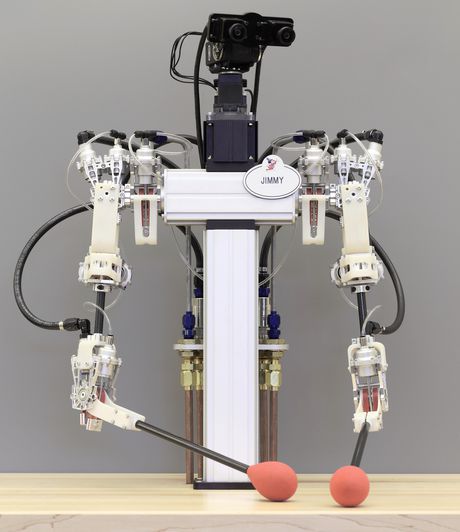Using pneumatics brings breakthroughs in robot design

Engineering360 has reported that robotics researchers are now combining pneumatics and hydraulics to more precisely control robot motion and force. A conventional robot joint design would use two hydraulic cylinders for movement in two directions. But the new transmission uses hydraulic power for movement in one direction and compressed air for movement in the other.
One example is the use of a pneumatic actuator to act as a constant-force air spring, exerting preload force against the hydraulic cylinder. This arrangement allows robot joints to move in two directions, but with only half the number of often-bulky hydraulic lines required by a completely hydraulic system.
It also virtually eliminates friction and play, allowing smooth and precise motion, said John Whitney, an assistant professor of mechanical and industrial engineering at Northeastern University. Whitney led the transmission-development effort for Disney Research, a network of research labs established by The Walt Disney Co.
A robot built by Disney Research relies on a hybrid hydraulic-pneumatic transmission for precise control. According to Whitney, the pneumatic preload pressure at the joint eliminates backlash by pre-tensioning the timing belts driving the system’s output shaft. In addition, he said, the cylinders feature rolling diaphragm seals, which substitute rolling for sliding motion and therefore produce almost no static friction during the stroke.
Whitney and his colleagues used the transmission to animate an upper-body humanoid robot designed for safe and lifelike interaction with people. The robot consists of an upper torso along with two light arms and a head fitted with stereo cameras that stream video to an operator who wears a virtual-reality headset. Visually immersed in the robot’s workspace, the operator moves the arms of a remote controller and the robot responds in real time.
Thanks to the transmission, which accurately relays forces due to its low friction and lack of play, the operator is able to feel the actual forces the robot experiences as it interacts with its environment. The designers claim this haptic feedback allows control precise enough for the robot to perform delicate tasks such as threading a needle or picking up an egg.
Possible real-world applications for the transmission include human-operated remote manipulation for microsurgery and hazardous material handling.
Another recent development featuring pneumatic components expands the reach of robot hands. Current industrial robots are specialists that generally excel at the specific tasks they’re designed for, but unable to handle much if anything beyond these tasks. Viewing such robots as inadequate for many situations, researchers from the University of Washington have come up with a robot that they say can learn new tasks over time and without human assistance.
The researchers believe their Adroit manipulation system is a step towards the creation of generalist robots capable of performing complex tasks in places such as healthcare facilities, spacecraft and even the home, where automated ‘butlers’ may someday handle many different chores.
Working in UW’s Movement Control Lab, the researchers built a five-fingered robot hand with 24 degrees of freedom (DOF), mounted on a 4 DOF arm. The system is equipped with roughly 135 sensors as well as external cameras that observe objects manipulated by the hand.
The hand’s actuator unit consists of commercially manufactured double-acting cylinders to control actuation force in opposite directions. Vikash Kumar, lead researcher for the Adroit project, said that pneumatic actuators were chosen because of their reliability, compactness and high force-to-weight ratio. The actuators feature a custom-designed glass chamber that allows smoother hand motion by reducing friction and stiction when the actuators are in motion.
All these special features and capabilities didn’t come cheap. “Since this is a research prototype, precise and high-cost components were chosen to answer our technical questions,” Kumar said of Adroit, which cost about $300,000. But for commercial use, he said, costs can be brought down by using less expensive components if the application allows it, or even eliminating components such as pressure sensors that may not be necessary in some situations.”
Cobots reduce employee lifting by 50%
As one of the world's largest meat producers, Danish Crown faces challenges in handling and...
Advanced robotics in tomorrow's factory
Addressing the production challenges of complexity, customisation and openness.
Cracking the nut: robotic automation at Freedom Fresh
SCARA robots from Shibaura Machine have found a place in helping to package macadamia nuts.







